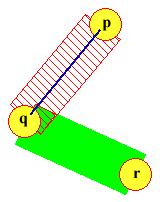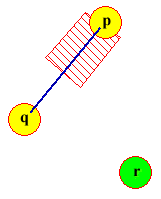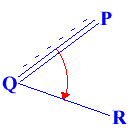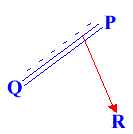4.1.2. Drawing
a reaction step rule
In this subsection 4.1.2 the relation more than
includes equality.
For distinct expressions p,q,r there are two methods to draw
an arrow in a reaction step rule to move a (single) bond
from the line (p,q) to the edge (q,r):
1. method
Select the line (p,q)
by pressing the mouse button with the cursor at less than
10 pixels from it and more than 8
from its ends p,q. Then release the mouse button
with the cursor at less than 10 pixels
from the edge (q,r) and
more than 8 from its ends r,q. |
2. method
Press the mouse button with the cursor in a position
closer to p than to q, less
than 10 pixels from the line
(p,q) and more than 8 from
p and successively release the mouse button
with the cursor at less than
8 pixels from r.
The bond can be imagined to turn around q from
p to r. |
These two methods to draw an arrow in a reaction step rule
are represented in the figures below. Figure 4.1 shows the 1. method,
Figure 4.2 the 2. method.
The mouse cursor must be pressed in the red dashed area and subsequently
released in the green area.
Figure 4.1
 |
Figure 4.2
 |
Two kinds of arrows can appear. If some line joins
q with r a circular arrow
is drawn (Figure 4.3), otherwise a straight arrow pointing to
r is produced (Figure 4.4).
Figure 4.3
 |
Figure 4.4
 |
<<
back

